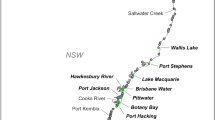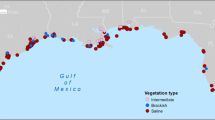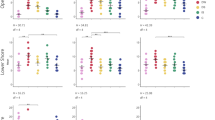Abstract
Historically, studies in landscape ecology have investigated how variation in spatial scale can affect the complex interactions observed in an ecosystem. In this study I describe survey data collected as part of the United States National Coastal Assessment that were used to discern the role sampling scale can play in detecting the relationship between physical factors and patterns of polychaete species diversity in marine estuaries. In this survey, sampling sites were randomly selected at three spatial scales using a probability based site selection algorithm applied to a GIS representation of all U.S. west coast estuaries. At each sampling scale, data relating to species diversity and environmental condition were collected. My analyses revealed that polychaetes displayed an increase in diversity towards the equator. It appears that across latitude both the rate of increase in and total diversity were affected by variation in the spatial scale over which the survey was conducted. Variation in scale also affected interpretations of the magnitude to which physical factors may potentially relate to species diversity across latitude. The data suggested that increased sampling scales obscured negative relationships between physical factors and species diversity across the estuaries sampled in this study. The results of this study demonstrate how assessments of the strength of the relationship between physical factors and species diversity in coastal communities can be strongly affected by variation in sampling scale.









Similar content being viewed by others
References
Anderson MJ, Millar RB (2004) Spatial variation and effects of habitat on temperate reef fish assemblages in northeastern New Zealand. J Exp Mar Biol Ecol 305:191–221
Attrill MJ (2002) A testable linear model for diversity trends in estuaries. J Anim Ecol 71(2):262–269
Bertness MD, Leonard GH (1997) The role of positive interactions in communities: lessons from intertidal habitats. Ecology 78:1976–1989
Billick I, Case TJ (1994) Higher order interactions in ecological communities: what are they and how can they be detected? Ecology 75(6):1529–1543
Brandt J (1998) Key concepts and interdisciplinarity in landscape ecology: a summing up and outlook. In: Dover JW, Bunce RGH (eds) Key concepts in Landscape Ecology. UK Association of International Landscape Ecology (IALE-UK), Garstang, Great Britain, pp 421–434
Chown SL, Gaston KJ (2000) Areas, cradles and museums: the latitudinal gradient in species richness. Trends Ecol Evol 15:311–315
Clarke A, Lidgard S (2000) Spatial patterns of diversity in the sea: bryozoan species richness in the North Atlantic. J Anim Ecol 69:799–814
Cornell HV, Karlson RH (2000) Coral species richness: ecological versus biogeographical influences. Coral Reefs 19:37–49
Crawley MJ, Harral JE (2001) Scale dependence in plant biodiversity. Science 291:864–868
Cullinan VI, Thomas JM (1992) A comparison of quantitative methods for examining landscape patterns and scale. Landsc Ecol 7: 211–227
Currie DJ (1991) Energy and large-scale patterns of animal and plant species richness. Am Nat 137:27–49
Cushman SA, McGarical K (2002) Hierarchical, multi-scale decomposition of species-environment relationships. Landsc Ecol 17:637–646
Dethier MN, Schoch GC (2005) The consequences of scale: assessing the distribution of benthic populations in a complex estuarine fjord. Est Cst Shlf Sci 62:253–270
Diniz-Filho JAF, Bini LM, Hawkins BA (2003) Spatial autocorrelation and red herrings in geographical ecology. Glob Ecol Biogeogr 12:53–64
Glover AG, Smith CR, Paterson GLJ, Wilson GDF, Hawkins L, Sheader M (2002) Polychaete species diversity in the central Pacific abyss: local and regional patterns and relationships with productivity. Mar Ecol Prog Ser 240:157–170
Godfray H, Lawton JH (2001) Scale and species numbers. Trends Ecol Evol 16:400–404
Guichard F, Halpin PM, Allison GW, Lubchenco J, Menge BA (2003) Mussel disturbance dynamics: signatures of oceanographic forcing from local interactions. Am Nat 161:889–904
Hewitt JE, Thrush SF, Cummings VJ, Turner SJ (1998) The effect of changing sampling scales on our ability to detect effects of large-scale processes on communities. J Exp Mar Biol Ecol 227:251–264
Hill JK, Hamer KC (2004) Determining impacts of habitat modification on diversity of tropical forest fauna: the importance of spatial scale. J Appl Ecol 41:744–754
Hunt HL, Scheibling RE (2001) Patch dynamics of mussels on rocky shores: integrating process to understand pattern. Ecology 82:3213–3231
Jelinski DE, Wu J (1996) The modifiable areal unit problem and implications for landscape ecology. Landsc Ecol 11:120–140
Johnson MP, Hawkins SJ, Hartnoll RG, Norton TA (1998) The establishment of fucoid zonation on algal-dominated rocky shores: hypotheses derived from a simulation model. Func Ecol 12:259–269
Kearns FR, Kelly NM, Carter JL, Resh VH (2005) A method for the use of landscape metrics in freshwater research and management. Landsc Ecol 20:113–125
King AW, Johnson AR, O’Neill RV (1991) Transmutation and functional representation of heterogenous landscapes. Landsc Ecol 5:239–253
Kozloff EN (1983) Seashore life of the Northern Pacific Coast: an illustrated guide to Northern California, Oregon and British Columbia. University of Washington Press
Kozloff, EN, Price LH (1996) Marine invertebrates of the Pacific Northwest. University of Washington Press
Legendre P (1993) Spatial autocorrelation: trouble or new paradigm? Ecology 74:1659–1673
Legendre P, Troussellier M (1988) Aquatic hetertrophic bacteria: modeling in the presence of spatial autocorrelation. Limnol Oceanogr 33:1055–1067
Legendre P, Thrush SF, Cummings VJ, Dayton PK, Grant J, Hewitt JE, Hines AH, McArdle BH, Pridmore RD, Schneider DC, Turner SJ, Whitlach RB, Wilkinson MR (1997) Spatial structure of bivalves in a sandflat: scale and generating processes. J Exp Mar Biol Ecol 216:99–128
Legendre P, Dale MRT, Fortin MJ, Gurevitch J, Hohn M, Myers D (2002) The consequences of spatial structure for design and analysis of ecological field surveys. Ecography 25:601–615
Lennon JJ (2000) Red-shifts and red herrings in geographical ecology. Ecography 23:101–113
Leonard GH, Levine JM, Schmidt PR, Bertness MD (1998) Flow-driven variation in intertidal community structure in a Maine estuary. Ecology 79:1395–1411
Leonard GH, Ewanchik PJ, Bertness MD (1999) How recruitment, intraspecific interactions and predation control species borders in a tidal estuary. Oecologia 118:492–502
Levin SA (1992) The problem of pattern and spatial scale in ecology. Ecology 73:1943–1967
Li H, Wu J (2004) Use and misuse of landscape indices. Landsc Ecol 19:389–399
Messer JJ, Linhurst RA, Overton WS (1991) An EPA program for monitoring ecological status and trends. Env Monit Assess 17:67–78
Murphy EJ, Morris DJ, Watkins JL, Priddle J (1988) Scales of interactions between Anarctic krill and the environment. In: Sarhage D (ed) Antarctic ocean and resource variability. Springer, Berlin Heidelberg New York, pp 120–130
O’Neill RV (1979) Transmutations across hierarchical levels. In: Innis GS, O’Neill RV (eds) Systems analysis of ecosystems. International Co-operative, Fairland, Maryland, USA, pp 59–78
Openshaw S, Taylor P (1981) The modifiable areal unit problem. In: Wrigley N, Bennett R (eds) Quantitative geography: a British view. Routledge and Kegan Paul, London
Perry JN, Leibold AM, Rosenberg MS, Dungan J, Miriti M, Jakomulska A, Citron-Poutst S (2002) Illustrations and guidelines for selecting statistical methods for quantifying spatial pattern in ecological data. Ecography 25:578–600
Pickett STA, Cadenasso ML (1995) Landscape ecology: spatial heterogeneity in ecological systems. Science 269:331–334
Qi Y, Wu J (1996) Effects of changing spatial resolution on the results of landscape pattern analysis using spatial autocorrelation indices. Landsc Ecol 11:39–49
Rackocinski CF, Brown SS, Gaston GR, Heard RW, Walker WW, Summers JK (2000) Species-abundance-biomass responses by estuarine macrobenthos to sediment chemical contamination. J Aqua Ecosys Strs Recov 7:210–214
Radeloff VC, Miller TF, He HS, Mladenoff DJ (2000) Periodicity in spatial data and geostatistical models: autocorrelation between patches. Ecography 23:81–91
Rahbeck C, Graves CR (2001) Multiscale assessments of avian species richness. Proc Natl Acad Sci USA 98:4534–4539
Rex MA, Stuart CT, Coyne G (2000) Latitudinal gradients of species richness in the deep-sea benthos of the North Atlantic. Proc Natl Acad Sci USA 97:4082–4085
Ricketts EF, Calvin J, Hedgpeth JW (eds) (1995) Between Pacific Tides, 5th ed. Stanford University Press
Risser PG, Karr JR, Forman RTT (1984) Landscape ecology: directions and approaches. Illinois Natural History Survey, Special Publication Number 2
Robles CD, Desharnais R (2002) History and current development of a paradigm of predation in rocky intertidal communities. Ecology 83:1521–1536
Rosenzweig ML (1995) Species diversity in space and time. Cambridge University Press, Cambridge, USA
Roy K, Jablonski D, Valentine JW, Rosenberg G (1998) Marine latitudinal diversity gradients: tests of causal hypotheses. Proc Natl Acad Sci USA 95:3699–3702
Rutherford S, D’Hondt S, Prell W (1999) Environmental controls on the geographic distribution of zooplankton diversity. Nature 400:749–753
Selmi S, Boulnier T (2001) Ecological biogeography of Southern Ocean Islands: the importance of considering spatial issues. Am Nat 158:426–437
Stevens DL (1994) Implementation of a national monitoring program. J Env Mngmnt 42:1–29
Stevens DL, Olsen AR (2004) Spatially balanced sampling of natural resources. J Am Stat Assoc 99:262–278
Takashi N (2004) Spatial hierarchical approach in community ecology: a way beyond high context-dependency and low predictability in local phenomena. Pop Ecol 46:105–117
Turner MG (1989) Landscape ecology: the effect of pattern on process. Ann Rev Ecol Syst 20:171–197
Turner MG, O’Neill RV, Gardner RH, Milne BT (1989) Effects of changing spatial scale on the analysis of landscape pattern. Landsc Ecol 3:153–162
Turner MG, Gardner RH (eds) (1991) Quantitative methods in landscape ecology. Springer-Verlag, New York
Turner MG, Gardner RH, O’Neill RV (2001) Landscape ecology in theory and practice: patterns and process. Springer-Verlag, New York, USA
USEPA (2001) National Coastal Assessment: Field Operations Manual. U.S. Environmental Protection Agency, Office of Research and Development, National Health and Environmental Effects Research Laboratory, Gulf Ecology Division, Gulf Breese, Fl, EPA 620/R-01/003
USEPA (2005) National Coastal Conditon Report II, U.S. Environmental Protection Agency, Office of Research and Development, National Health and Environmental Effects Research Laboratory, EPA-620 R-03/002
Van de Koppel J, Rietkerk M, Dankers N, Herman PMJ (2005) Scale-dependent feedback and regular spatial patterns in young mussel beds. Am Nat 165:66–77
Velho LFM, Lansac-Toha FA, Bonecker CC, Bini LM (2001) The longitudinal distribution of copepods in Corumba reservoir, state of Goaias, Brasil. Hydrobiology 453:385–391
Warwick RM, Clarke KR (1993) Increased variability as a symptom of stress in marine communities. J Exp Mar Biol Ecol 175:215–226
Willis KJ, Whittaker RJ (2002) Species diversity-scale matters. Science 295:1245–1248
Wilson WG, Nisbet RM (1997) Cooperation and competition along smooth environmental gradients. Ecology 78:2004–2017
Wu J (1992) Detecting spatial patterns: the net-function interpolation. Coenoses 7:137–143
Wu J (2004) Effects of changing scale on landscape patterns analysis: scaling relations. Landsc Ecol 19:125–138
Wu J, Levin SA (1994) A spatial patch dynamic modeling approach to patterns and process in annual grassland. Ecol Monogr 4:447–464
Wu J, Loucks OL (1995) From balance-of-nature to hierarchical patch dynamics: a paradigm shift in ecology. Quart Rev Biol 70:439–466
Wu J, Hobbs R (2002) Key issues and research priorities in landscape ecology: an idiosyncratic synthesis. Landsc Ecol 17:355–365
Wu J, Shen W, Sun W, Tueller PT (2002) Empirical patterns of the effects of changing scale on landscape metrics. Landsc Ecol 17:761–782
Acknowledgments
This manuscript benefited from comments provided by R. Desharnais, V. Engle, J. Harvey and W. Nelson. Two anonymous reviewers provided comments on the manuscript. Data were compiled and provided by L. Harwell of the United States Environmental Protection Agency. The views expressed in this paper do not necessarily reflect the views of the United States Environmental Protection Agency and no official endorsement should be inferred.
Author information
Authors and Affiliations
Corresponding author
Rights and permissions
About this article
Cite this article
Garza, C. Relating spatial scale to patterns of polychaete species diversity in coastal estuaries of the western United States. Landscape Ecol 23 (Suppl 1), 107–121 (2008). https://doi.org/10.1007/s10980-007-9142-2
Received:
Accepted:
Published:
Issue Date:
DOI: https://doi.org/10.1007/s10980-007-9142-2




